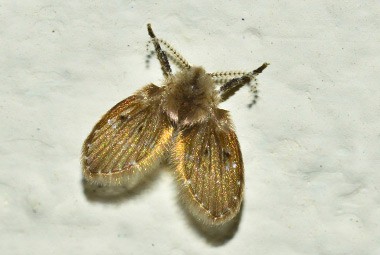
Moth flies are found living through most of the United States, including Missouri. They are referred to as “moth” flies because of their fuzzy appearance. They are also commonly called drain or sewer flies because they are often found living in those environments.
| Pest Identification | |
|---|---|
| Recognition | Moth flies get their name from the fact that their bodies, wings, and antennae are covered in microscopic fuzz. They are a small fly species with adults only growing to between 1/5th and 1/16th of an inch in length. They have large oval wings that are held in a roof-like position when they are at rest. These flies are weak, erratic fliers that only fly for short periods of time. |
| Biology | The life cycle of the moth fly begins with the females and males mating. The females will then lay 30 to 100 eggs in the debris found in pipes, sewers, and drains. If the temperature is warm enough (about 70 degrees), the eggs will hatch in 32 to 48 hours; the larvae feeds on the sludge that they were laid in for 8 to 24 days. They then enter the pupal stage for 20 to 40 hours emerging as adults. Adults live a very short life of about 2 weeks. |
| Habits | Moth flies are more often seen crawling on vertical surfaces than flying. During the daytime, they can be found resting inside near drain openings or in shady areas outside. Moth flies lay their eggs in the moist gooey build-up found in drains; because of this, it is very common for homeowners to see adult moth flies in bathrooms and kitchens. Moth flies will also take up residence in the spaces found behind walls and in crawl spaces. Moth flies are most active during the evening hours. Even though these flies are found living in bacteria-laden areas like sewers, drains, and pipes, they actually are not known to transmit any diseases to people and are generally seen as nuisance pests in homes and other properties. |
| Prevention | Along with putting into place a year-round pest control program, the only effective way to prevent problems with moth flies is to routinely take apart and clean out drains that are located in your home. Simply pouring a drain cleaner down the drain is not effective. The debris needs to be physically scooped out and removed. |
| Professional | Stop moth fly infestations with professional pest control. When you choose Rottler, we’ll determine if moth flies are present and develop a treatment plan that gets rid of these flies. While every infestation is unique, treatment for moth flies often includes the use of appropriately labeled botanical, microbial, and/or enzymatic insecticides and insect growth regulators in floor drains, wastewater traps, and other breeding sites along with the installation of insect light traps. |

